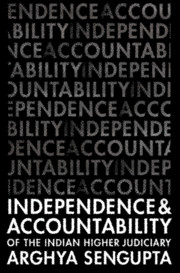Book contents
- Frontmatter
- Dedication
- Contents
- Acknowledgements
- List of Abbreviations
- List of Cases
- List of Statutes
- 1 Introduction
- PART I THE INDIAN EXPERIENCE
- PART II A CONCEPTUAL ANALYSIS
- 5 Judicial Accountability
- 6 Judicial Independence
- 7 In Search of an Effective Judiciary: A Doctrinal Reconciliation of Judicial Independence and Accountability
- PART III TYING THE STRANDS
- Epilogue: The Moment the Judiciary Came Out
- Appendix Post-Retirement Employment of Judges in Government-Appointed Positions
- Bibliography
- Index
5 - Judicial Accountability
from PART II - A CONCEPTUAL ANALYSIS
Published online by Cambridge University Press: 26 April 2019
- Frontmatter
- Dedication
- Contents
- Acknowledgements
- List of Abbreviations
- List of Cases
- List of Statutes
- 1 Introduction
- PART I THE INDIAN EXPERIENCE
- PART II A CONCEPTUAL ANALYSIS
- 5 Judicial Accountability
- 6 Judicial Independence
- 7 In Search of an Effective Judiciary: A Doctrinal Reconciliation of Judicial Independence and Accountability
- PART III TYING THE STRANDS
- Epilogue: The Moment the Judiciary Came Out
- Appendix Post-Retirement Employment of Judges in Government-Appointed Positions
- Bibliography
- Index
Summary
ACCOUNTABILITY: A VERY BRIEF CONCEPTUAL OVERVIEW
The advent of judicial accountability as a widespread phenomenon is a relatively modern development. It grew as an institutional response to the growing power of courts in adjudicating matters that were hitherto not considered within the ambit of judicial resolution. Its intellectual progenitor, from which it derived both its terminology and its conceptual moorings, is the concept of public accountability, which itself underwent a new wave in the latter half of the twentieth century. Previously, public accountability was an under-theorised and seldom discussed concept. In democratic theory, it had a settled meaning, applicable to elected representatives, who had to be accountable to their constituents; in public administration, it denoted a traditional book-keeping function, true to its etymological roots. However, caught at the confluence of the twin developments of the multiplication of power centres within the state requiring multiple sites of accountability and theories of New Public Management redefining traditional public administration understandings, the concept of public accountability exploded, suddenly being used in a variety of ways, with multiple meanings and diverse objectives.
To document and analyse each of these meanings and objectives is the task of an accountability historian and beyond the scope of this chapter. I am concerned with the limited task of sifting through these multiple understandings in order to delineate a plausible conceptual core of judicial accountability. This conceptual account is bolstered by jurisdiction-specific examples that demonstrate the various ways in which judicial accountability is used in practice. Such an account will provide a matrix to understand the particular dimensions of judicial accountability which are, much to our intellectual detriment, significantly under-theorised today.
Two parallel developments in governance and public administration are responsible for the profusion of the uses of public accountability in the latter half of the twentieth century. In governance, there was an increasing realisation that the traditional conception of public accountability of elected representatives, that is, ministerial responsibility to parliament in the Westminster tradition, was inadequate for a number of reasons. Thus, direct bureaucratic accountability to parliament, administrative accountability to courts and accountability of various governmental authorities directly to the people were offered as necessary supplements.
- Type
- Chapter
- Information
- Independence and Accountability of the Higher Indian Judiciary , pp. 119 - 139Publisher: Cambridge University PressPrint publication year: 2019



